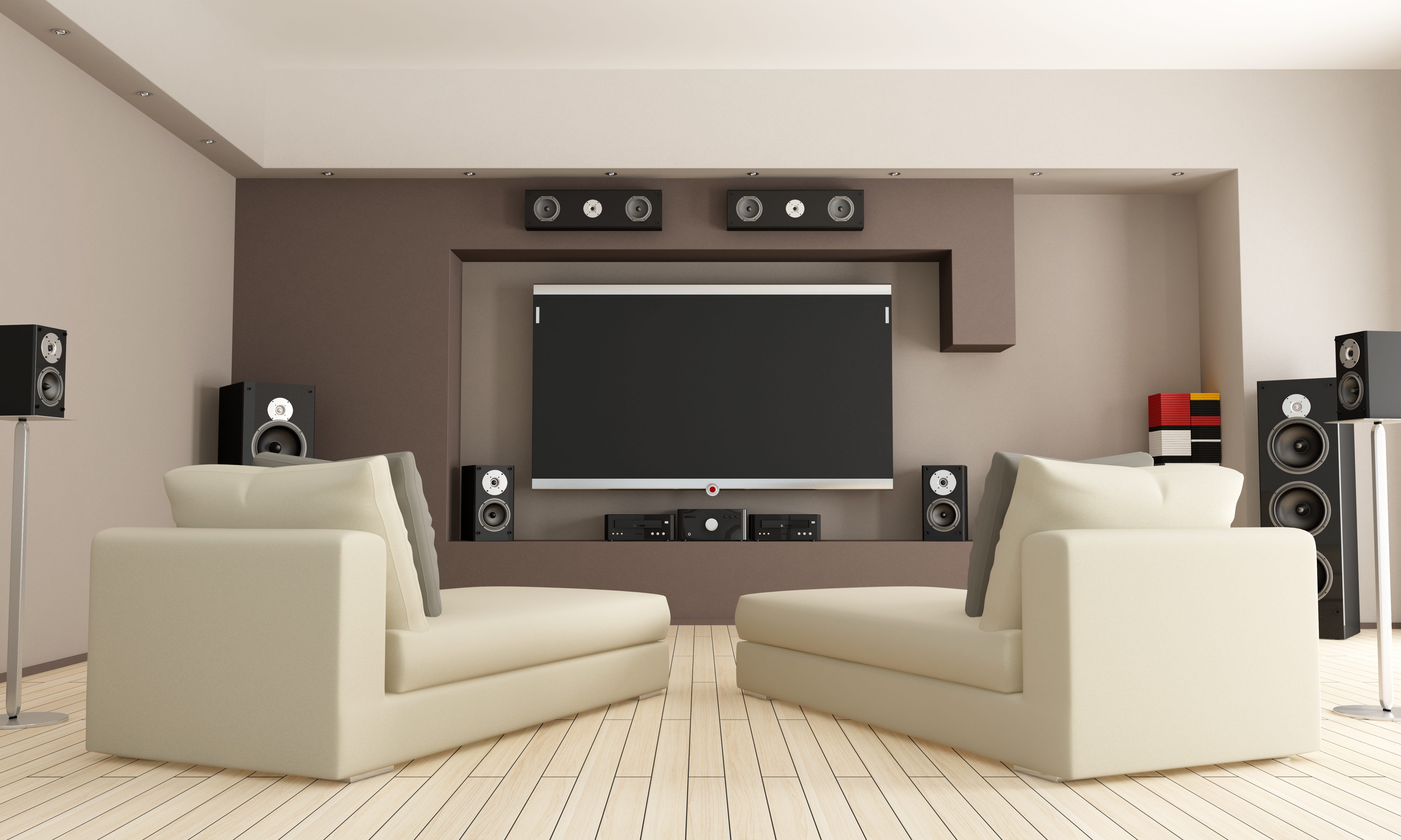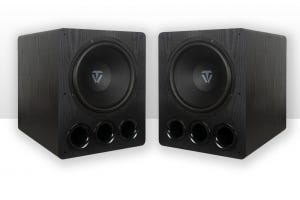
High quality cinema from home is becoming increasingly popular with the rise of online streaming services and as we all spend more time at home during the pandemic. Movie theatres may never again exist as we once knew them, so now is a better time than ever to start watching hi-def movies from home.
A home theatre doesn’t have to be extravagant or an entire room dedicated to watching movies. It can even be as simple as having a surround sound system that mimics the experience of a movie theatre right in your living room. If you’re considering investing in a home theatre, or you just want to level up your at-home TV experience, these are the basic components you may need:
Video Source
Of course, you need a source for the media you will be watching. There are a variety of options for media sources:
DVD or Bluray player: This is one of the most common ways to watch movies. An Ultra HD bluray player is highly recommended, especially if you have a nice display. In order to get the most out of your TV or projector, you need a source that supports hi def playback. Similarly, if your display system supports 3D, consider a bluray player that is 3D capable.
Media streamer: Streaming is quickly taking over the media industry. Many people prefer to have a smart TV with built-in access to streaming services. You can also opt for a plug-in streamer like an amazon firestick or apple TV. Additionally, many bluray players have internet connection capabilities to access streaming sites.
Gaming console: Instead of a bluray player, you can use a gaming console like an Xbox or Playstation to play video content. New generation consoles will support UltraHD streaming. As a bonus, hooking up your console to a hifi sound system is a nice treat if you like single-player videogames already.
Turntable: Okay, this is not a video source, but many people like to use their sound system for music as well. If you’re going to have surround sound equipment, might as well give this a try.
Display
Another no-brainer here – a home theatre system requires a display. There are two main options that each have benefits and drawbacks: a TV or a projector.
TV Display
Although it may not be a “true” theatre, HDTVs these days are great high-performance displays for home theatres. If you really want theatre-quality picture, UltraHD or 4k is highly recommended over 720p or even 1080p. As stated before, some TVs come with streaming services built-in. TVs are suitable for living room theatres because they accommodate different lighting conditions, so you can watch at any time of the day even if you don’t have full control over the light level in the room. There are two types of TV screens to choose from:
- OLED: In an OLED TV, each individual pixel is emitting light, so there is no backlight. This makes these TV models ultra-thin, and the screen produces a detailed, high-contrast image. This screen type is generally more expensive, but also more environmentally friendly.
- LCD/LED: An LED TV uses a backlight to illuminate the screen. These TVs still produce a beautiful image and can be more affordable than the OLED counterpart.
The screen size you need depends on the size of the room, and your budget, but obviously, a bigger screen is going to make a more immersive home theatre. To have an enjoyable home theatre experience, a 50-inch screen at least is recommended. Generally, the distance between the viewer and the screen should be 2-3 times the width (not diagonal) of the display.
Projector + Screen
For a more authentic home theatre experience, you’ll need a projector. This is the preferred display option for true cinema geeks, and it can actually be the more affordable option for a large display. The biggest limitation of projectors is that the room must be very dark to get a vibrant, theatre-quality image; they are well suited for dedicated home theatre rooms, or just be sure you have full control over the light level in the room. Here are some considerations to make when choosing a projector:
- Throw ratio: Each projector is made for a specific throw ratio, or the ratio between the distance from the projector to the screen and the width of the screen (throw ratio = distance/width). So, before choosing a projector, you want to have a pretty good idea of the screen size you need and how far away the projector will be placed. High-end theatre projectors designed to be permanently installed often feature interchangeable lenses to adjust the throw ratio, but otherwise, you will be stuck with what you got.
- Lumens: This refers to the brightness capabilities of the projector. A smaller, darker room will require less lumens than a large theatre-sized room or a dimly lit setting. It’s always smart to go with more lumens than you think you will need, because you can always turn the brightness down, but if your projector doesn’t have enough brightness, there is no way to increase the contrast.
- Resolution: For smaller screens, XGA resolution (1024 x 768) is usually satisfactory. For a dedicated home theatre, consider at least WXGA (1280 x 800) or higher. Most home theatre projectors offer Full HD resolution anyways, or you can opt for 4K.
Screen size just depends on the size of the room and your personal preferences; you can use the same reasoning as a TV screen. Alternatively, consider the ‘least favored viewer’, or the location of the viewer that will be furthest away from the screen. The distance from the screen to the least favored viewer should be about five times the screen height. Typically, 16:9 is the preferred screen shape, since it is versatile and pretty standard. Some film lovers prefer a 2.35:1 to watch CinemaScope ultra-wide films without seeing the black bars.
Speaker System
A surround sound system is arguably the most important component of a home theatre. If you want an immersive cinema experience, you must be willing to invest in hifi audio. But it doesn’t have to be a multi-thousand-dollar advanced audio system. Here are the main options for immersive audio:
A soundbar: The most affordable way to get hifi sound is with a soundbar. The speaker goes directly under the TV or projector screen and features three separate speakers pointed at different angles to mimic a surround sound experience. Many soundbars come with a subwoofer, which will greatly improve the audio quality, since soundbars themselves are not equipped to produce strong bass frequencies.
Surround sound system: If you afford a larger investment, a full surround sound speaker system is highly recommended. This includes the following:
- A centre speaker placed directly under or above the screen to emphasize dialogue
- Left and right speakers in the front, which are either bookshelf or floorstanding
- Optional left and right ‘surround’ speakers in the back, which are typically bookshelf or other small speakers
- A subwoofer to boost bass frequencies, which is not always necessary if you have larger floorstanding speakers already
You can buy these speakers separately or find a surround sound bundle that has everything you need included.
Integrated sound system: If you don’t want to have a full speaker set taking up space in the room, opt for discreet in-wall and in-ceiling speakers. These are suitable for dedicated home theatre rooms since they must be permanently installed, however, they do not always offer the same quality of audio, since they are generally smaller and more compact in nature. You can still pair a subwoofer with these speakers to boost bass frequencies.
Professional grade theatre speakers: For serious film lovers, it is possible to bring commercial grade cinema directly into your home with modular speaker systems just like the ones used in the theatre. These, of course, are a serious investment, costing upwards of $5,000 and require professional installation.
Sound Equipment
This part of a home theatre system is often overlooked. With a hifi sound system, you must have devices to process sound information and distribute it to the speakers. You have two ways to do this:
- A preamplifier and an amplifier: A preamp, or processor, will take the audio from the source (your bluray player, TV, turntable, etc.) and boost/process the signal into a format suitable for speakers. The signal then needs to go to an amplifier to be boosted to a proper output level. Buying these devices separately is preferred by audiophiles, as it offers greater control over sound quality. However, it is the more expensive option.
- A/V receiver: A receiver is a preamplifier, tuner, and amplifier all in one device. These are more affordable and still offer great quality. This is largely the preferred method for processing sound unless you have specific audio taste.
Choosing a sound processing device can be difficult if you don’t know what you’re looking for, or you’re hardly even sure what a receiver or amplifier does. The good news is: it doesn’t matter all that much. Look up recommended devices for the speakers you own, and you should be good to go. If you’re into informed decision-making, these are the most important things to consider:
- I/O: The number and type of inputs and outputs needs to be compatible with your gear. If you want to connect the TV and a turntable, you need at least two inputs. Take note of the types of inputs, such as HDMI, USB, or coaxial digital and analog.
- Number of channels: The number of channels you need depends on the number of speakers in your system. Opting for extra channels won’t hurt just in case you decide to get more speakers down the road.
- Power rating: The amplifier’s power rating refers to its ability to boost the audio signal. You only need to pay attention to the power rating if you have large, power-hungry speakers.
- Wired vs wireless: You can opt for a wireless system if your speakers are compatible. This is much more convenient than running wires all over the place, but generally does not offer the same quality level, or is susceptible to latency issues.
Room Design and Acoustics
Any time you are using a surround sound system, there are ways to optimize the speaker placement in the room to get the best audio quality. If you have flexibility, you want to orient your setup long-ways in the room with the seating in a somewhat central location. Soft, absorbent surfaces will reduce the reflection of sound waves, which is critical for getting even, balanced sound throughout the room. When sound waves reflect off of the floor and walls, they will either combine to amplify frequencies or cancel each other out to reduce frequencies in certain areas of the room. If possible, treat your room acoustically, or at the very least, put out a large rug if you have hard flooring to absorb some of the sound waves.
Cable Organisation and Accessories
Once you have all of these electronics set up, you will realize the importance of cable organisation. Cable ties or boxes are great ways to hide cords and keep them tidy. Alternatively, you can run cables through the walls, which is generally preferred when you have a dedicated theatre room.
Accessories such as a universal remote can be quite useful when you are dealing with 10+ pieces of equipment. An entry or mid-level remote can control multiple devices, may have a touchscreen, and will be easy to program. High-end controllers for more complex systems are professionally installed and programmed to control lighting, screen masking, AV devices, and more.





